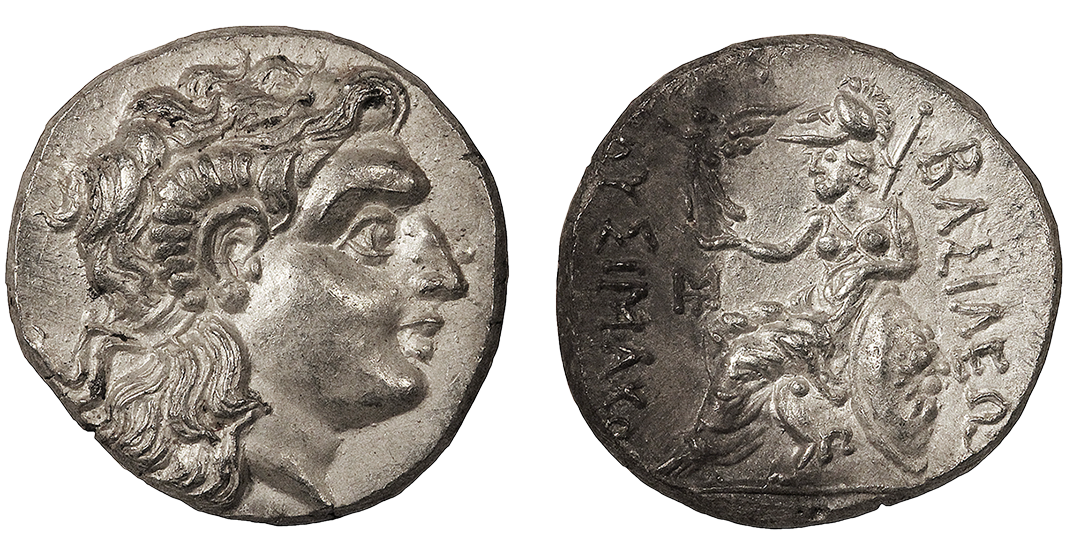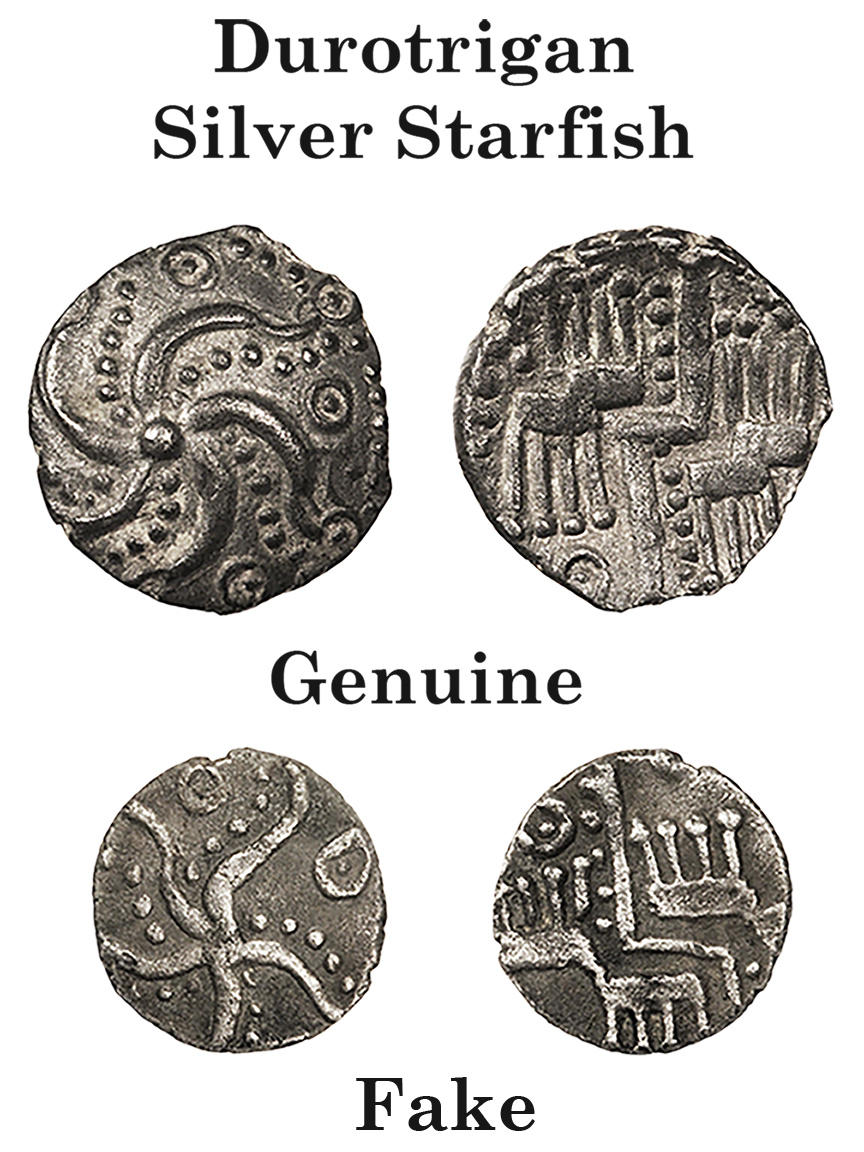
Numismatic Articles
Van Arsdell 2021a (Info)
Modern Celtic Fakes 12 – Replicas from Bulgaria
By Robert D. Van Arsdell
Introduction
In an earlier article, I suggested there may be a new forger making fakes of British Celtic coins. (Info) It appears that some of these coins may be coming from replica studios in Bulgaria.
The replica studios in Plovdiv, Haskovo and Sofia are well-known. (Info) Some of them produce artistic re-creations of ancient coins and sell them on the open market as replicas. Probably the best-known is Coinlandia in Plovdiv, whose work is impressive.
Generally, the replica studios don't try to produce exact duplicates of ancient coins. Instead, they cut dies to create images "in the style of" the original. These replicas are sufficiently different so they shouldn't be confused with genuine ancient objects. People collect these replicas for their beauty, creativity and craftmanship.
The Bulgarian replicas of Greek and Roman coins haven't been a concern to Ancient British numismatics. But in the last few years, some of the less-accomplished workshops appear to have turned their attention to the British Celtic series. The replicas they produce are crude and shouldn't be confused with genuine Celtic coins. However, a survey of some recent productions might be useful.
1) High Quality Replicas
The discussion should begin with the work of the better workshops in Bulgaria. This will give an idea of the quality of die-cutting they can produce.
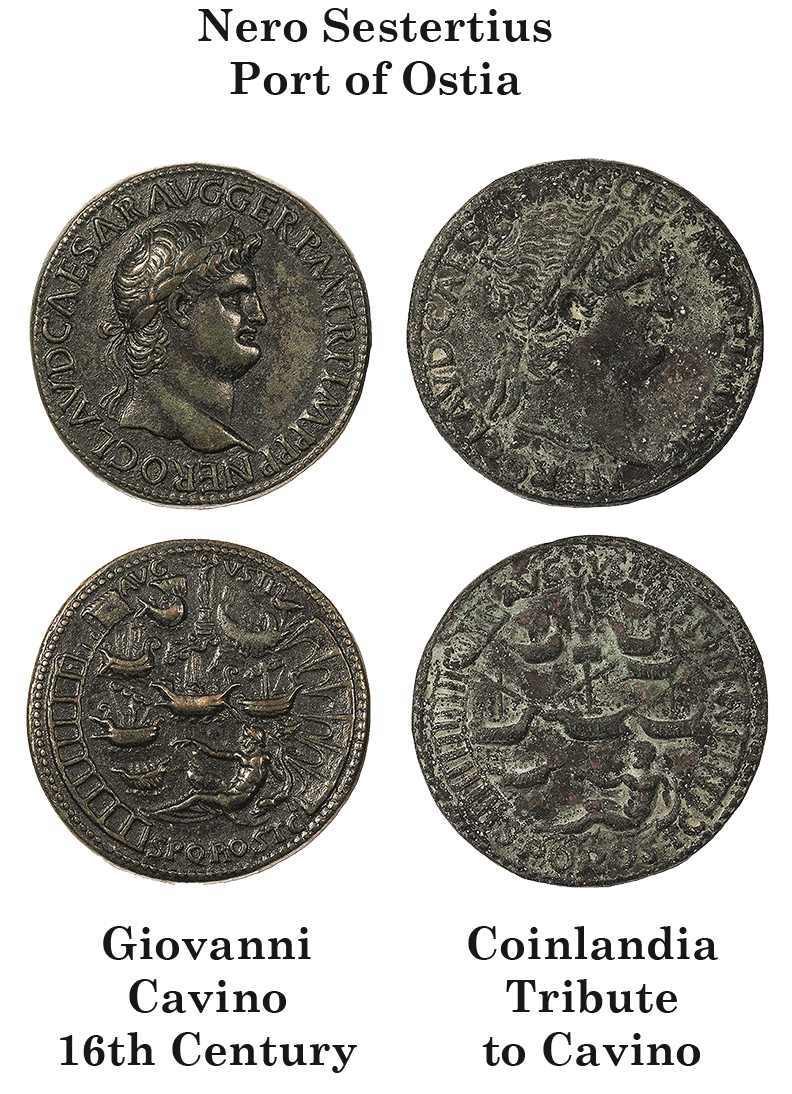
Coinlandia recently introduced a "Tribute to Cavino" sestertius of Nero. Their Port of Ostia type is a pleasing replica, but wouldn't be mistaken for a genuine Roman coin. Giovanni Cavino created his replica in the 1500s.
The tribute coin compares well to the original Cavino in style. Cavino used a chemical means to produce his pleasing patination. The Coinlandia piece has a coating of ground-up bronze corrosion instead. Thus, the two replicas don't appear identical in the photo.
Ilya Prokopov has decribed the way the Bulgarian workshops grind up corroded ancient coins and glue the mixture to replicas with a brush. (Info)
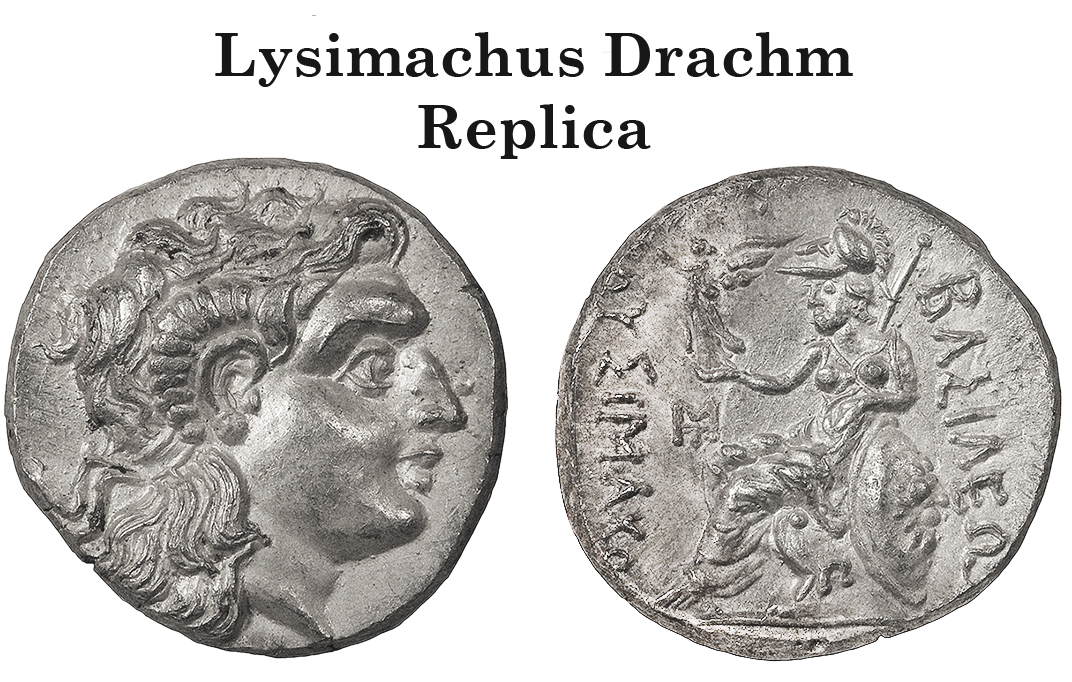
This Lysimachus replica shows expert die cutting. There's been no attempt to "antique" the coin, either by creating wear or patination. Thus, the coin looks fresh from the mint, not like one that's been buried in the ground for thousands of years.
Since the replica was made, it's suffered some uneven discolouration on the reverse. For the purpose of illustration, this has been removed digitally, using Photoshop editing software. The actual appearance of the replica can be seen: (Here)
This replica was sold as the work of a renowned Bulgarian die-cutter, but it's uncertain whether it truly was made by that person. Thus, the workshop must remain unknown, for now.
These two examples show that the best Bulgarian workshops should be capable of producing excellent replicas of Ancient British coins. The expert work from Bulgaria far exceeds the Haselmere forger's best efforts. Fortunately, the British Celtic fakes from Bulgaria currently offered don't approach this high level.
Replicas and Fakes of British Types
All of the British Celtic fakes seen to date are so crude that they cannot have been produced to deceive collectors. Indeed, it's doubtful whether the die-cutters have seen genuine examples of the coins. The replicas have probably been produced as novelties for use in coin jewelry or keychains, or else as items for museum gift shops.
The problem, in this case, is with the resellers. The Internet's become the best place to find crude fakes to study. All of the following ones have been rounded up from Internet sellers in the UK. They've been careful not to mention whether the coins are genuine ancient objects – it's been up to the buyers to make that determination. Caveat Emptor!
The first two fakes attempt to recreate known British types, a Silver Starfish and a Cast Bronze of the Durotriges. There are also fakes of Durotrigan struck bronze staters. Unfortunately, I have no example of those to illustrate. (More)
The next fakes are a series of crude fantasy types that share an assembly-line kind of production. They're all made on fairly standardized miniature flans. The forgers have not tried to produce coins of the correct size. The die-cutters have made all kinds of dies to correspond to the miniature flans. Generally, the images are completely made-up and fail to correspond to any genuine type.
All these items appear to be the products of Bulgarian workshops, based on the way they have been offered on the Internet. It's possible that some non-Bulgarian items have been included.
2) Replicas of Ancient British types

A geniune Silver Starfish is a well-made coin. The die cutting is sharp and crisp. For the most part, the coins were well-centred when they were struck.
There is absolutely nothing correct about the fake Silver Starfish.
The size and weight are wrong. The imagery is nothing like that of a genuine coin.
The fake doesn't even appear to have been struck from dies. The image elements are unsharp and there are no microscopic flow-lines anywhere on the coin. Raised blobs of metal appear all over the fields. The fake appears to be a casting.
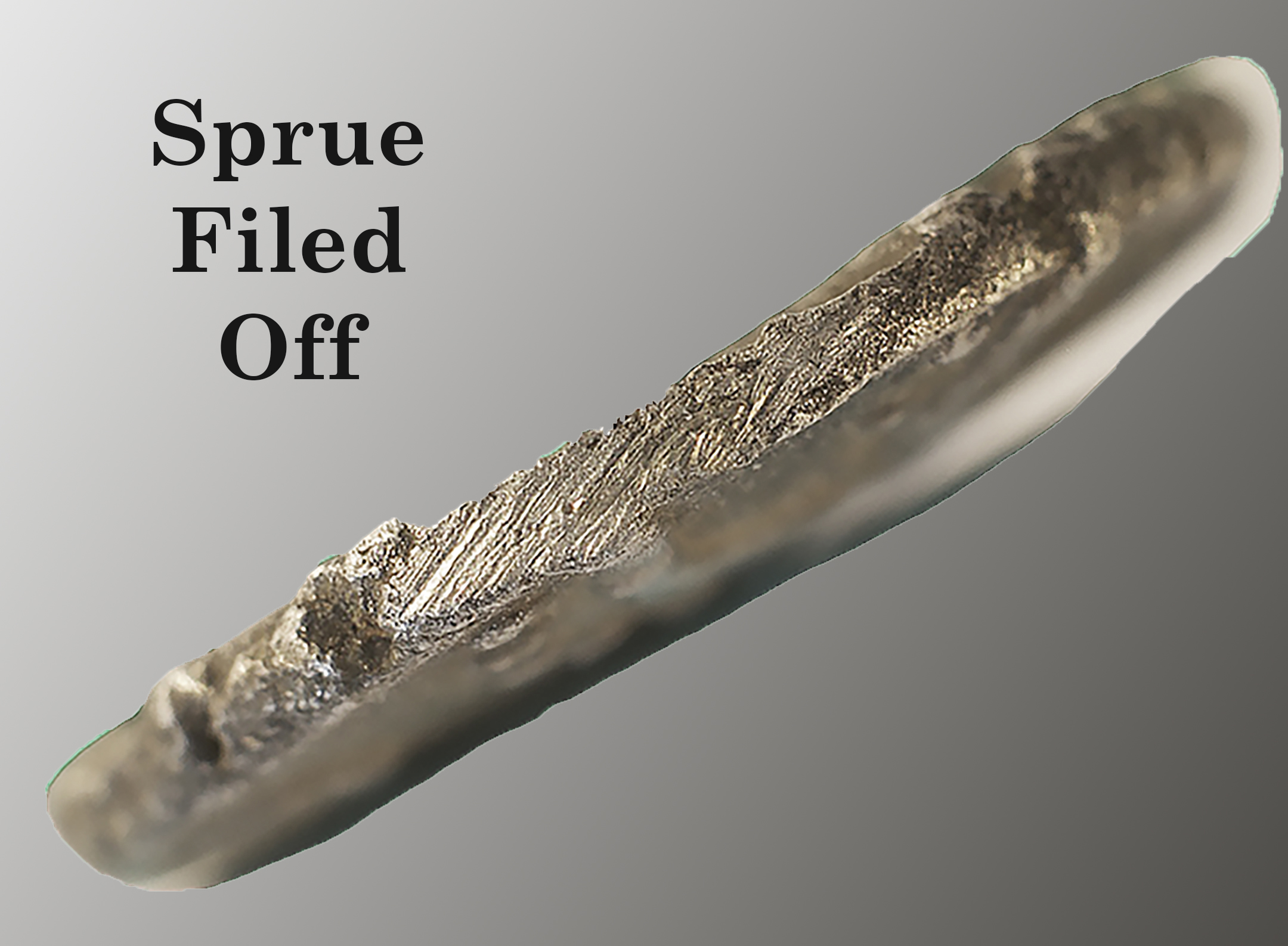
The casting sprue has been roughly filed off from the edge of the coin. The forger's made no attempt to hide the file marks. Normally, the sprue would be carefully filed down, and the file marks would then be removed by heating the spot with a needle torch. The file marks would melt and no longer be visible. (Info)
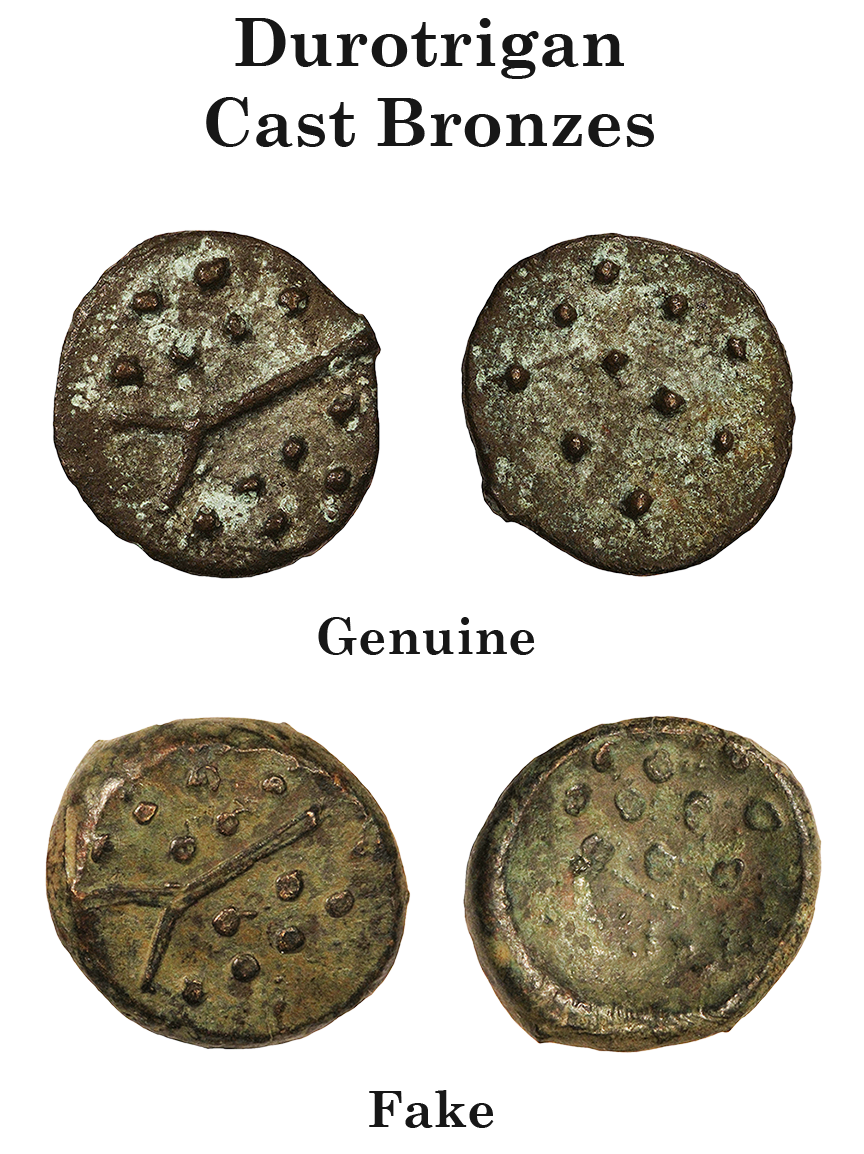
Durotrigan Cast Bronzes are distinctive objects. They don't look like Kentish Cast Bronzes nor Thurrock types. The dots appear to be pressed in deeply with small rods, making the coins slightly thicker than most Kentish types. The "Y" is carefully made on most coins.
Again, there is almost nothing correct about the fake.
The fake is too thick and the reverse is concave.
The "Y" has been created in a sloppy manner and the junction of with the arms is poorly done. The dots are nothing like those on a genuine coin.
The fake does appear to be a casting, but the sprue is nothing like that on the genuine type and it's in the wrong place.
3) Novelty Items
The following fakes make no attempt to duplicate genuine coins. It's difficult to believe the producers were attempting to create anything more than novelty items. None of these coins (or others like them) should be mistaken for genuine ancient objects.
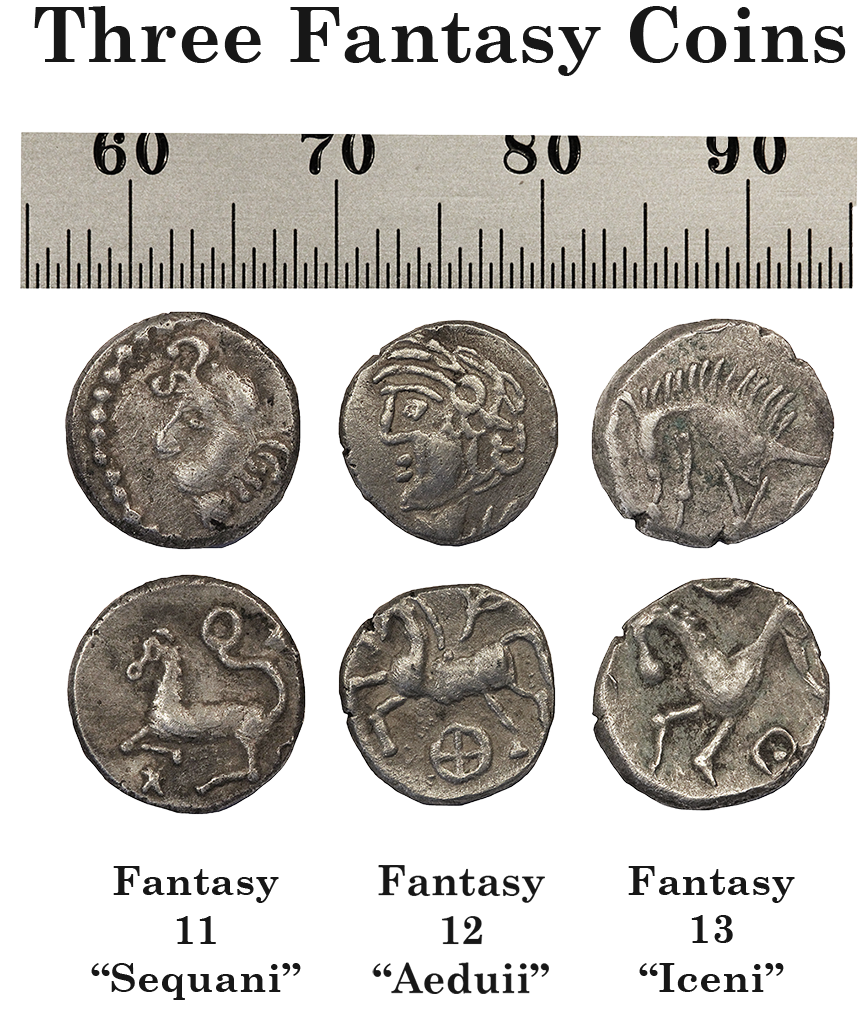
These three fantasy types have no known counterparts. They're generally too small and light to be real coins (MM scale).
For the most part, the imagery is completely made-up, and nothing like that on genuine Celtic coins.The die cutting is crude and inept. Often there is no attempt to hide the die cutting mistakes.
The "Aeduii" fantasy might be a crude attempt to recreate DT3199, but isn't very convincing. The "Iceni" is like no known genuine coin, it's just a crude attempt to produce something reminiscent of Icenian silver units. The "Sequani" has been discussed in a previous article. (Info)
Summary
The Bulgarian replica studios produce a wide range of products. The best replicas are truly works of art, and are collectible objects in themselves.
Recent replicas of British Celtic coins have been produced by studios with less expertise, and appear to be nothing more than novelty items. Unfortunately, they have been offered without proper identification (as replicas) by sellers on the Internet. Collectors and students of the British Celtic series should be on guard.
End

